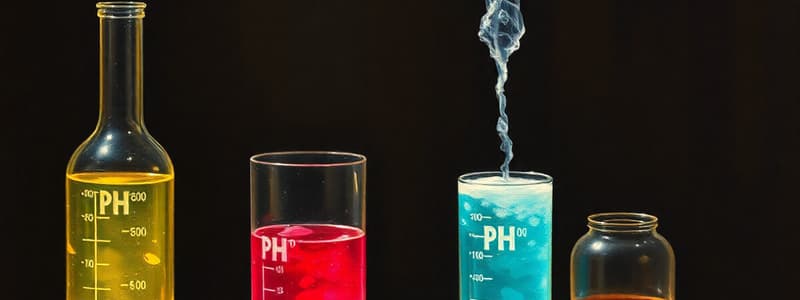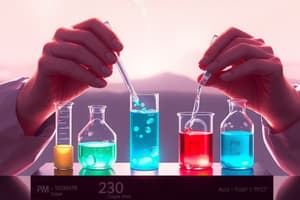Podcast
Questions and Answers
Which statement accurately describes an Arrhenius acid?
Which statement accurately describes an Arrhenius acid?
- A substance that increases the concentration of hydroxide ions when dissolved in water.
- A substance that accepts electrons.
- A substance that increases the concentration of hydronium ions when dissolved in water. (correct)
- A substance that donates protons in solution.
According to the Bronsted-Lowry definition, what characterizes a base?
According to the Bronsted-Lowry definition, what characterizes a base?
- It donates a proton.
- It produces hydroxide ions in aqueous solution.
- It accepts a proton. (correct)
- It accepts electrons.
Which definition of acids and bases focuses on electron transfer?
Which definition of acids and bases focuses on electron transfer?
- Lewis definition (correct)
- Neutralization definition
- Arrhenius definition
- Bronsted-Lowry definition
In a titration, 1.0 mL of 0.1 N HCl neutralizes 0.0053 g of $Na_2CO_3$. What is the equivalent factor (F) if a sample is titrated with a standard solution?
In a titration, 1.0 mL of 0.1 N HCl neutralizes 0.0053 g of $Na_2CO_3$. What is the equivalent factor (F) if a sample is titrated with a standard solution?
In the reaction $CO_3^{2-} + H_2O \rightarrow HCO_3^- + OH^-$, which species is acting as a base?
In the reaction $CO_3^{2-} + H_2O \rightarrow HCO_3^- + OH^-$, which species is acting as a base?
What is the defining characteristic of strong acids, such as HCl and $H_2SO_4$, in aqueous solution?
What is the defining characteristic of strong acids, such as HCl and $H_2SO_4$, in aqueous solution?
If HNO3 is a strong Bronsted acid, what can be said about its conjugate base $NO_3^−$?
If HNO3 is a strong Bronsted acid, what can be said about its conjugate base $NO_3^−$?
In the reaction $HF + H_2O \rightleftharpoons H_3O^+ + F^-$, which species is the conjugate base?
In the reaction $HF + H_2O \rightleftharpoons H_3O^+ + F^-$, which species is the conjugate base?
Which of the following is a key difference between strong and weak acids in an aqueous solution?
Which of the following is a key difference between strong and weak acids in an aqueous solution?
In the context of acid-base chemistry, what does the term 'conjugate base' refer to?
In the context of acid-base chemistry, what does the term 'conjugate base' refer to?
Which of the following properties distinguishes a Lewis acid from a Bronsted-Lowry acid?
Which of the following properties distinguishes a Lewis acid from a Bronsted-Lowry acid?
In the reaction H3PO4(aq) + NH3(aq) ⇌ H2PO₄⁻(aq) + NH₄⁺(aq), what are the conjugate acid-base pairs?
In the reaction H3PO4(aq) + NH3(aq) ⇌ H2PO₄⁻(aq) + NH₄⁺(aq), what are the conjugate acid-base pairs?
What is the primary reason why CH3COO⁻ is a stronger base than Cl⁻?
What is the primary reason why CH3COO⁻ is a stronger base than Cl⁻?
Which statement best describes the behavior of a substance that is acting as a Lewis base?
Which statement best describes the behavior of a substance that is acting as a Lewis base?
Which characteristics apply to strong bases? (Select all that apply)
Which characteristics apply to strong bases? (Select all that apply)
What is the pH of a 0.1 M HCl solution (a strong acid)?
What is the pH of a 0.1 M HCl solution (a strong acid)?
What is the defining characteristic of a 'weak acid' in solution?
What is the defining characteristic of a 'weak acid' in solution?
Which statement would be true regarding solutions of strong acids and bases?
Which statement would be true regarding solutions of strong acids and bases?
Given a weak acid with a $K_a$ of $1.75 \times 10^{-5}$, which expression correctly calculates its pH? (Consider $C_a$ as molar concentration of the acid)
Given a weak acid with a $K_a$ of $1.75 \times 10^{-5}$, which expression correctly calculates its pH? (Consider $C_a$ as molar concentration of the acid)
Which of the following is the correct formula for calculating the pH of a solution of a weak base?
Which of the following is the correct formula for calculating the pH of a solution of a weak base?
Milk of Magnesia, Mg(OH)₂, is used as an antacid. Based on this information, how does it function chemically?
Milk of Magnesia, Mg(OH)₂, is used as an antacid. Based on this information, how does it function chemically?
What is the pH of a salt formed from the reaction of a strong acid and a strong base?
What is the pH of a salt formed from the reaction of a strong acid and a strong base?
Which statement accurately describes the pH of a salt formed from a strong acid and a weak base?
Which statement accurately describes the pH of a salt formed from a strong acid and a weak base?
What formula is used to calculate the pH of the salt of a strong acid and a weak base?
What formula is used to calculate the pH of the salt of a strong acid and a weak base?
What is the expected pH of a salt solution made by reacting a weak acid with a strong base?
What is the expected pH of a salt solution made by reacting a weak acid with a strong base?
Which formula is correctly applied to calculate the pH of a salt derived from a weak acid and a strong base?
Which formula is correctly applied to calculate the pH of a salt derived from a weak acid and a strong base?
What type of salt solution is formed from the reaction of a weak acid and a weak base?
What type of salt solution is formed from the reaction of a weak acid and a weak base?
Which formula should be used to determine the pH of a salt solution derived from a weak acid and a weak base?
Which formula should be used to determine the pH of a salt solution derived from a weak acid and a weak base?
A 0.20 M ammonium chloride solution has a $K_b$ for ammonia of $1.8 \times 10^{-5}$. Which conclusion can be made about it?
A 0.20 M ammonium chloride solution has a $K_b$ for ammonia of $1.8 \times 10^{-5}$. Which conclusion can be made about it?
If the $K_a$ for HCN is $5.8 \times 10^{-10}$, what is the expected pH of a 0.50 M solution of KCN?
If the $K_a$ for HCN is $5.8 \times 10^{-10}$, what is the expected pH of a 0.50 M solution of KCN?
What is the pH of a 0.40 M KBr solution, given that KBr is the salt of a strong acid (HBr) and a strong base (KOH)?
What is the pH of a 0.40 M KBr solution, given that KBr is the salt of a strong acid (HBr) and a strong base (KOH)?
Flashcards
Arrhenius acid
Arrhenius acid
Any substance that, when dissolved in water (ionize), increases the concentration of hydronium ion (H3O+).
Arrhenius base
Arrhenius base
Any substance that, when dissolved in water (ionize), increases the concentration of hydroxide ion (OH-).
Bronsted-Lowry acid
Bronsted-Lowry acid
A substance that donates a proton (H+).
Bronsted-Lowry base
Bronsted-Lowry base
Signup and view all the flashcards
Conjugate base
Conjugate base
Signup and view all the flashcards
Conjugate acid
Conjugate acid
Signup and view all the flashcards
Strong Acid
Strong Acid
Signup and view all the flashcards
Lewis acid
Lewis acid
Signup and view all the flashcards
Lewis base
Lewis base
Signup and view all the flashcards
Acids that completely ionize and donate all its protons
Acids that completely ionize and donate all its protons
Signup and view all the flashcards
pH Formula
pH Formula
Signup and view all the flashcards
Strong Base
Strong Base
Signup and view all the flashcards
What is the formula connecting pH and pOH
What is the formula connecting pH and pOH
Signup and view all the flashcards
Weak Acid
Weak Acid
Signup and view all the flashcards
The equation for the pH of a weak acid
The equation for the pH of a weak acid
Signup and view all the flashcards
The equation for the pH of a weak base
The equation for the pH of a weak base
Signup and view all the flashcards
Salts derived from strong acids and bases
Salts derived from strong acids and bases
Signup and view all the flashcards
Salts derived from strong acids and weak bases
Salts derived from strong acids and weak bases
Signup and view all the flashcards
The equation for pH of solution derived from strong acids and weak bases
The equation for pH of solution derived from strong acids and weak bases
Signup and view all the flashcards
Salts derived from weak acids and strong bases
Salts derived from weak acids and strong bases
Signup and view all the flashcards
The equation for pH of solution derived from weak acids and strong bases
The equation for pH of solution derived from weak acids and strong bases
Signup and view all the flashcards
Study Notes
Acid-Base Titrations
Intended Learning Outcomes
- To define acids and bases
- To differentiate between acids and bases.
- To calculate the pH of acidic, basic and salt solutions.
Equivalent factor
- The equivalent factor calculation for the reaction Na2CO3 + 2 HCl -> 2 NaCl + H2O + CO2 involves determining the relationship between moles of reactants
- 2 moles of HCl are equivalent to 1 mole of Na2CO3.
- The equivalent weight of Na2CO3 is calculated as M.wt Na2CO3 / 2.
- F (Equivalent weight of sample x Normality of standard) / 1000
Definitions of Acids and Bases
- Acids are substances that taste sour and turn blue litmus paper red.
- Bases are substances that taste bitter and turn red litmus paper blue.
- These are not necessarily reliable definitions.
Acid Definitions
Arrhenius Acid
- Any substance that increases the concentration of hydronium ions (H3O+) when dissolved in water.
Bronsted-Lowry Acid
- Any substance that produces proton(s).
Lewis Acid
- An electron acceptor.
Base Definitions
Arrhenius Base
- Any substance that increases the concentration of hydroxide ions (OH-) when dissolved in water.
Bronsted-Lowery Base
- A base is any substance that accepts proton(s).
Lewis Base
- An electron donor.
Arrhenius Acids and Bases
- Arrhenius acids increase the concentration of hydronium ions (H3O+) when dissolved in water, while Arrhenius bases increase the concentration of hydroxide ions (OH-).
- Acidic properties are due to the dissolved proton.
- Alkaline properties are due to the dissolved hydroxide.
Bronsted-Lowry Definition
- A Bronsted-Lowry acid is a proton (H+) donor.
- A Bronsted-Lowry base is a proton (H+) acceptor.
- The stronger the acid, the weaker its conjugate base, and vice versa.
- Strong acids such as HCl, H2SO4, and HNO3 ionize completely in aqueous solution.
- Weak acids "slightly/partially" ionize or dissociate.
- Hydrogen cyanide is a weak Bronsted acid, but the cyanide anion is a strong conjugate base.
Lewis Definition of Acids & Bases
- Lewis acid: An electron acceptor.
- Lewis base: An electron donor.
- Lewis acids typically include cations, species without complete valence shells, and electron-deficient conjugated systems.
- Lewis bases typically include species with lone pairs, anions, and electron-rich conjugated systems.
pH of Acids, Bases, and Salts
- Strong acids have a pH = -log[H+].
- Strong bases have a pOH = -log[OH-].
- Weak acids have a pH = ½ pCa + ½ pKa.
- Weak bases have a pH = pKw - ½ pCb - ½ pKb.
- Salts of strong acids and strong bases have a pH of 7.
- Salts of strong acids and weak bases have a pH = ½ pKw - ½ pKb + ½ pCs.
- Salts of strong bases and weak acids have a pH = ½ pKw + ½ pKa - ½ pCs.
- Salts of weak bases and weak acids have a pH = ½ pKw + ½ pKa - ½ pKb.
- Strong acids are those that completely ionize and donate all their protons, such as hydrochloric acid (HCl), hydroiodic acid (HI), hydrobromic acid (HBr), nitric acid (HNO3), perchloric acid (HClO4), and the first proton of sulfuric acid (H2SO4).
- pH of strong acids can be calculated as pH = -log[H+].
- Strong bases are those that completely ionize and donate all their hydroxide ions, such as NaOH, KOH.
- Kw = pH + pOH
- pH for strong bases can be calculated as pH= 14 - pOH
- Weak acids such as aqueous acetic acid, most of the acid remains undissociated, with only a small fraction present as the conjugate base.
- The pH for weak acids can be calculated as pH = ½ pCa + ½ pKa
- Weak base reaction BOH ⇌ B+ +OH-
- The pH for weak basecan be calculated as pH = pKw- 1/2pCb - 1/2 pKb
Studying That Suits You
Use AI to generate personalized quizzes and flashcards to suit your learning preferences.



